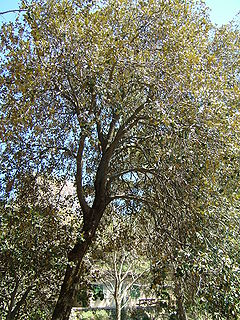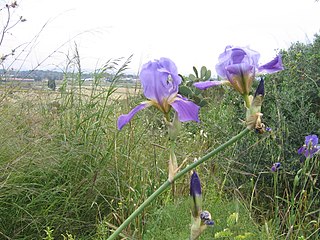
Tilia platyphyllos is a species of flowering plant in the family Malvaceae (Tiliaceae). It is a deciduous tree, native to much of Europe, including locally in southwestern Great Britain, growing on lime-rich soils. The common names largeleaf linden and large-leaved linden are in standard use throughout the English-speaking world except in the British Isles, where it is known as large-leaved lime. The name "lime", possibly a corruption of "line" originally from "lind", has been in use for centuries and also attaches to other species of Tilia. It is not, however, closely related to the lime fruit tree, a species of citrus.

Rosa multiflora is a species of rose known commonly as multiflora rose, baby rose, Japanese rose, many-flowered rose, seven-sisters rose, Eijitsu rose and rambler rose. It is native to eastern Asia, in China, Japan and Korea. It should not be confused with Rosa rugosa, which is also known as "Japanese rose", or with polyantha roses which are garden cultivars derived from hybrids of R. multiflora.

Bellis perennis is a common European species of daisy, of the family Asteraceae, often considered the archetypal species of that name.

Silene dioica, known as red campion and red catchfly, is a herbaceous flowering plant in the family Caryophyllaceae, native throughout central, western and northern Europe, and locally in southern Europe.
Athertonia is a genus of tall trees, constituting part of the plant family Proteaceae. It is a monotypic taxon, and the sole described species is Athertonia diversifolia, commonly known as Atherton oak. It is a small to medium-sized tree and is endemic to restricted tablelands and mountainous regions of the wet tropics rain forests of north-eastern Queensland, Australia, where it is widespread. For example, it grows in the Atherton Tableland region with which it shares its name, from the colonial pastoralist John Atherton (1837–1913). Its closest relatives are Heliciopsis and Virotia. A relative of the macadamia, it has potential as an ornamental tree and has an edible nut.

Banksia grandis, commonly known as Bull Banksia, Giant Banksia or Mangite, is a common and distinctive banksia tree in South West Western Australia. The Noongar peoples know the tree as Biara, Boongura, Baalgaara/ Paalaagara or Peera.

Prunella vulgaris is a herbaceous plant in the genus Prunella.

Quercus alnifolia, commonly known as the golden oak, is an evergreen oak species of Cyprus. Its common English name refers to the golden coloured lower surface of its leaves. Quercus alnifolia belongs to the endemic flora of the island and it is confined to the igneous geological complex of the Troodos Mountains. In February 2006, the parliament of Cyprus selected the golden oak to be the country's national tree.

Commelina diffusa, sometimes known as the climbing dayflower or spreading dayflower, is a pantropical herbaceous plant in the dayflower family. It has been introduced to the southeastern United States where it is most common in wet disturbed soils. There are two recognised varieties, one being the type and the other being C. diffusa var. gigas, which is native to Asia and has been introduced to Florida. It flowers from spring to fall and is most common in disturbed situations, moist places and forests. In China the plant is used medicinally as a febrifuge and a diuretic. A blue dye is also extracted from the flower for paints. In the Hawaiian Islands, it is known as "honohono grass", although it is technically not a grass. "Honohono" refers to the alternating structure of the leaves. At least one publication lists it as an edible plant in New Guinea.

Echinops sphaerocephalus, known by the common names glandular globe-thistle, great globe-thistle or pale globe-thistle, is a Eurasian species of globe-thistle belonging to the thistle tribe within the sunflower family.

Malus baccata is an Asian species of apple known by the common names Siberian crab apple, Siberian crab, Manchurian crab apple and Chinese crab apple. It is native to much of northern Asia, but is also grown elsewhere as an ornamental tree and for rootstock. It is used for bonsai. It bears plentiful fragrant white flowers and edible red to yellow fruit of about 1 cm diameter.

Argyranthemum frutescens, known as Paris daisy, marguerite or marguerite daisy, is a perennial plant known for its flowers. It is native to the Canary Islands. It is also widely cultivated as an ornamental planted in private gardens and public parks in many countries, and naturalized in Italy and southern California. There are many varieties, but the most common has white petals.

This is not the same species - What was Rhamnus frangula is now classified as Frangula Alnus and is an invasive, non-native.

Persoonia chamaepitys, commonly known as the prostrate- or mountain geebung, is a shrub endemic to New South Wales in eastern Australia. It has a prostrate habit, reaching only 20 cm (7.9 in) high but spreading up to 2 m (6.6 ft) across, with bright green spine-like leaves and small yellow flowers appearing in summer and autumn.
Brassica hilarionis is a hairless perennial up to 1 m high with a basal rosette of roundish, fleshy, flat-stalked leaves, upper leaves stalkless and stem-clasping. Has large loose racemes of creamy white flowers with petals up to 2.5 cm long. Narrow beaked pods up to 7 cm. Flowers from March to May.
Pimpinella cypria, common name Cyprus burnet-saxifrage and locally Kıbrıs Pimpinela, is a herbaceous perennial plant belonging to the Carrot family (Apiaceae).
Sedum lampusae Is an erect herb to 50 cm, dying after one flowering. Basal leaves flat, glaucous, fleshy, spoon-shaped, 4–10 cm long, forming neat rosette which usually shrivels before the flowers open; steam leaves progressively smaller; inflorescence a long cylindrical or pyramidal spray, flowers numerous, crowded, brownish green, calyx-lobes and petals both 5, the latter narrow, pointed, 4 mm long, with a dark central vein. Stamens 10, follicles usually 5, erect, 5 mm long. Flowers from June to August. Common name is Lapta Damkoruğu.
Rosularia cypria is a tufted perennial with grey-green, sticky-downy spoon-shaped fleshy leaves, 3–4 cm long, in a loose rosette above an often bare basal trunk; flowering stems to 20 cm, carrying a few more similar leaves; flowers in terminal sprays to 12 cm long with leaf like bracts of diminishing size; calyx densely glandular with 5 deep-cut, broad, lobes forming a 5-angled pyramid; corolla-lobes white, recurved, 8–10 mm long with slender points; fruits comprising 5 papery, many-seeded follicles, circa 4 mm. Flowers from April to July. Common name Kıbrıs Göbekotu.
Iris cypriana is a species in the genus Iris, it is also in the subgenus of Iris. It is a rhizomatous perennial, from Cyprus. It has narrow, glaucous and evergreen leaves, tall slender stem, with 2–3 branches, and 1–3 large flowers in lavender, lilac, red-lilac, to dark purple shades. It is cultivated as an ornamental plant in temperate regions. It is listed in some sources as a synonym of Iris germanica.

Iris mesopotamica is a species in the genus Iris, it is also in the subgenus of Iris. It is a rhizomatous perennial, from the middle East, within the countries of Turkey, Syria and Israel. It has linear, grey-green or green broad leaves, tall stem with 2–3 branches, holding up to 9 scented flowers, in shades of violet, purple, lavender blue and light blue, with a yellow and white or orange and white beard. It is listed as a synonym of Iris germanica in some sources. It is cultivated as an ornamental plant in temperate regions, including being planted in graveyards and cemeteries.













